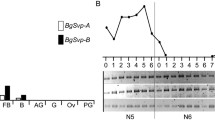Abstract
Insect molting and metamorphosis are orchestrated by ecdysteroids with juvenile hormone (JH) preventing the actions of ecdysteroids necessary for metamorphosis. During the molt and metamorphosis of the dorsal abdominal epidermis of the tobacco hornworm, Manduca sexta, the isoforms involved in the ecdysone receptor (EcR)/Ultraspiracle (USP) complex change with the most dramatic switch being the loss of USP-1 and the appearance of USP-2 during the larval and pupal molts. We show here that this switch in USP isoforms is mediated by high 20-hydroxyecdysone (20E) and that the presence of JH is necessary for the down-regulation of USP-1 mRNA. The decrease of USP-1 mRNA in day 2 fourth instar larval epidermis in vitro required exposure to a high concentration (10–5 M) of 20E equivalent to the peak ecdysteroid concentration in vivo, whereas the increase of USP-2 mRNA occurred at lower concentrations (effective concentrations, EC50=6.3×10–7 M). During the pupal molt of allatectomized larvae which lack JH, USP-2 mRNA increased normally with the increasing ecdysteroid titer, whereas USP-1 mRNA remained high until pupation. When day 2 fifth instar larval epidermis was exposed to 500 ng/ml 20E in the absence of JH to cause pupal commitment of the cells by 24 h, USP-1 RNA remained at its high preculture level for 12 h, then increased two- to threefold by 24 h. The increase was prevented by the presence of 1 µg/ml JH I which also prevents the pupal commitment of the cells. By contrast, USP-2 mRNA increased steadily with the same EC50 as in fourth stage epidermis, irrespective of the presence or absence of JH. Under the same conditions, mRNAs for both EcR-B1 and EcR-A isoforms were up-regulated by 20E, each in its own time-dependent manner, similar to that seen in vivo. These initial mRNA increases were unaffected by the presence of JH I, but those seen after 12 h exposure to 20E were prevented by JH, indicating a difference in response between larvally and pupally committed cells. The presence of JH which maintained larval commitment of the cells also prolonged the half-life of the EcR proteins in these cells. These results indicate that both EcR and USP RNAs are regulated by 20E and can be modulated by JH in a complex manner with only that of USP-2 apparently unaffected.
Similar content being viewed by others
Author information
Authors and Affiliations
Additional information
Received: 16 July 1998 / Accepted: 5 August 1998
Rights and permissions
About this article
Cite this article
Hiruma, K., Shinoda, T., Malone, F. et al. Juvenile hormone modulates 20-hydroxyecdysone-inducible ecdysone receptor and ultraspiracle gene expression in the tobacco hornworm, Manduca sexta . Dev Gene Evol 209, 18–30 (1999). https://doi.org/10.1007/s004270050223
Issue Date:
DOI: https://doi.org/10.1007/s004270050223




